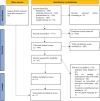Noble element coatings on endotracheal tubes for ventilator-associated pneumonia prevention: A systematic review and meta-analysis of randomized controlled trials in emergency care settings
- PMID: 39312345
- PMCID: PMC11419469
- DOI: 10.1097/MD.0000000000039750
Noble element coatings on endotracheal tubes for ventilator-associated pneumonia prevention: A systematic review and meta-analysis of randomized controlled trials in emergency care settings
Abstract
Background: Ventilator-associated pneumonia (VAP) is the second most prevalent nosocomial infection in emergency care settings. An emerging strategy to reduce this risk involves coating endotracheal tubes (ETTs) with noble elements, leveraging the antimicrobial properties of elements such as silver, gold, and palladium. This systematic review and meta-analysis aimed to evaluate the effectiveness of noble element coatings on ETTs in reducing VAP incidence rates, mortality, duration of mechanical ventilation, and length of stay in the intensive care unit (ICU).
Methods: Adhering to the Preferred Reporting Items for Systematic Reviews and Meta-Analyses guidelines, a comprehensive search was conducted across 5 databases up to 2024. The quality of the randomized controlled trials was assessed using the updated Cochrane Risk of Bias (RoB) 2 tool. A random-effects meta-analysis was performed using RevMan 5.4 Comprehensive Meta-Analysis software. Statistical heterogeneity among the studies was evaluated using the Higgins I2 value, with P < .05 indicating statistical significance.
Results: Seven randomized controlled trials from 5 countries were identified. Four studies had some concerns regarding bias, 2 had a high RoB, and 1 had a low RoB. Noble metal-coated ETTs resulted in a lower incidence of VAP compared to noncoated ETTs (relative risk, 0.76 [95% confidence interval [CI], 0.60-0.96]). However, there was no significant difference in mortality rates (relative risk, 1.06 [95% CI, 0.93-1.20]), duration of mechanical ventilation (mean difference, -0.10 [95% CI, -1.62 to 1.41]), and ICU stay (mean difference, 0.07 [95% CI, -1.98 to 2.12]).
Conclusion: Noble metal-coated ETTs effectively reduce the incidence of VAP but do not significantly impact mortality rates, the duration of mechanical ventilation, or ICU stay. Therefore, these coated ETTs should be integrated into a holistic care plan addressing all aspects of patient management in emergency care settings.
Copyright © 2024 the Author(s). Published by Wolters Kluwer Health, Inc.
Conflict of interest statement
The authors have no conflicts of interest to disclose.
Figures





Similar articles
-
Prevention of ventilator-associated pneumonia by metal-coated endotracheal tubes: a meta-analysis.Crit Care. 2024 Sep 17;28(1):309. doi: 10.1186/s13054-024-05095-8. Crit Care. 2024. PMID: 39289732 Free PMC article.
-
Efficacy of Noble Metal–alloy Endotracheal Tubes in Ventilator-associated Pneumonia Prevention: a Randomized Clinical Trial.Balkan Med J. 2022 May 24;39(3):167-171. doi: 10.4274/balkanmedj.galenos.2021.2021-7-86. Epub 2022 Mar 25. Balkan Med J. 2022. PMID: 35332771 Free PMC article. Clinical Trial.
-
Silver-coated endotracheal tubes and incidence of ventilator-associated pneumonia: the NASCENT randomized trial.JAMA. 2008 Aug 20;300(7):805-13. doi: 10.1001/jama.300.7.805. JAMA. 2008. PMID: 18714060 Clinical Trial.
-
Biofilm formation on three different endotracheal tubes: a prospective clinical trial.Crit Care. 2020 Jun 29;24(1):382. doi: 10.1186/s13054-020-03092-1. Crit Care. 2020. PMID: 32600373 Free PMC article.
-
Does chlorhexidine reduce the incidence of ventilator-associated pneumonia in ICU patients? A systematic review and meta-analysis.Med Intensiva (Engl Ed). 2023 Aug;47(8):437-444. doi: 10.1016/j.medine.2022.11.002. Epub 2022 Dec 1. Med Intensiva (Engl Ed). 2023. PMID: 36464582
References
-
- Wagh H, Acharya D. Ventilator associated pneumonia--an overview. Br J Med Pract. 2009;2:16–9.
-
- Scott RD. The direct medical costs of healthcare-associated infections in US hospitals and the benefits of prevention. Division of Healthcare Quality Promotion National Center for Preparedness, Detection, and Control of Infectious Diseases Coordinating Center for Infectious Diseases Centers for Disease Control and Prevention, Atlanta. 2009.
Publication types
MeSH terms
LinkOut - more resources
Full Text Sources

